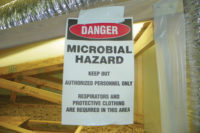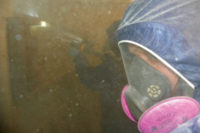Buildings, or portions thereof, are often vacated as part of restoration and remediation projects. Some folks “volunteer” to be relocated, and others have to be “volun-told” to get out! Most occupants are averse to being forcibly displaced. And most building owners and managers loathe watching their building being evacuated. Let’s shed a little light on this touchy subject, so you’re not caught off-guard when it is time to make the tough call.
It’s Complicated
Making the call to vacate, or conversely to maintain occupancy, at a property should not be taken lightly. There are far reaching ramifications to consider, some involve human health and safety, some are economical and some are psychological. Evacuating the building can have consequences like additional living expenses, business interruption claims, lost lease renewals and bad press. Staying put can have negative impacts, such as putting people in harm’s way, opening up risk of litigation or citation and bad press.
To laymen, building evacuations are cut and dry decisions. But rarely are things as easy as they seem on the surface. Here are a few seemingly obvious reasons to vacate a building: fire, earthquake, tornado, chemical spill. These are somewhat extreme examples, but the principles are the same for a water leak, a mold issue, an asbestos situation, etc. You will need a modicum of expertise and as many facts as can be mustered before you make the call to send people packing or to leave them in place.
Common complicating factors include building type (e.g. is it a house, apartment, office building, school, medical building, senior living center, restaurant, etc.) and occupant demographics (e.g. are the occupants infants, children, elderly, healthy workers, etc.). An obvious evacuation threshold for one building type and one population may not be so obvious for another building and population combinations.
The Fog of War
Obtaining project details and sifting through the chaff is a process. This process takes time. And, time is in scarce supply on projects. You gather any available details before dispatching, and you soak up the site conditions upon arrival to the project. But, you know the information gathering ordeal is filled with rabbit holes, dead ends, misinformation and panic stricken players (owners, tenants, emergency responders, etc.). Yet, you must make critical decisions through this fog of war.
Damned if You Do, Damned if You Don’t
Acting on partial information at the time of an incident is part of the expected duties. You act on what you know, because failure to act might produce a worse outcome. Your action, or your lack of action, could result in injuries to bystanders or workers, damages to property and extensions of liability. Weigh the pros and cons of the available information, make a decision and move forward. You can always stop, turn left, turn around or forge ahead as additional information becomes available.
Document, Document, Document and Did I Mention Document?
When you are hip-deep in handling an emergency, the last thing on your mind is documentation. Documentation must be a priority because the emergency will end, and the details will be lost. You continually adjust your response as additional information becomes available. It is critical for you to document the information in the order you receive it. Field decisions may have to be made before all facts are available. If you had all the facts on hour one, you may have chosen an alternate path. Being able to recount why you did or did not vacate the building and when you made the call is a critical tool you won’t possess after the job is done unless you wrote it down as you went.
You Will Be Judged by the MMQ and the ACQ
A person who criticizes the actions of others using hindsight is known as a “Monday Morning Quarterback.” And, there is no shortage of Monday Morning Quarterbacks (MMQs) on restoration and remediation projects. A good example of being judged by MMQs post-event is the notorious competitive bid. This is when a competing professional is neatly handed all the pertinent incident information after a response is complete and asked if they would have done it better, cheaper or differently. This is the business equivalent giving me last week’s winning lottery numbers and then asking if I would have won the lottery with that information. Of course I would have won the lottery with the winning numbers in hand! But, emergency service projects are not neatly boxed up and tied in a bow for you. They are chaotic messes from which you must help to restore order.
Worse than the Monday Morning Quarterback (MMQ) is the Arm Chair Quarterback (ACQ). The ACQ is also a person who judges your work after the emergency is over and all the facts are neatly available, but who lacks the technical expertise to perform the job themselves. They not only judge you after the fact, but do so without the knowledge, experience or ability to actually have performed the work under any circumstance. Think news anchor, tenant or politician, client, etc.
Why Might You Call For Relocation of Occupants?
There are many reasons to relocate occupants on a project, here are 7 common ones:
- You Must Be Tripping: Trip hazards are incredibly high on a restoration project. In a flood situation, the slip and fall hazards are almost too numerous to list: wet floors, the inevitable extension cord spaghetti, Hubble cords, dehumidifier tubing, vacuum hoses, flex tubing, lay flat tubing, etc. Even with tape and cord management, there is a danger to occupants of tripping. In particular the elderly, who rely upon assisted mobility (e.g. wheelchair, walker, cane) or simply shuffle as they walk due to limited agility, should be considered. They are more susceptible to tripping and more likely to suffer a life altering injury as a result of the associated crash landing.
- Hot, Hot, Hot: The heat output and resultant increased indoor temperatures produced by drying equipment may feel nice in Montana in February, but in Phoenix in the summer, it will quickly cook a house well upwards of 120 degrees Fahrenheit. Add in some elevated humidity from drying materials, and you get a highly effective sauna. This may be great for your skin, but it is unbearable for occupants and downright dangerous.
- It Slices. It Dices. It Makes Julienne Fries! Children stick their fingers in everything from their noses to electrical sockets. Air movers are equally fascinating to toddlers. Although equipment is generally shrouded or screened-in to keep fat adult fingers out of moving parts, toddler fingers can find their way into small and dangerous nooks and crannies. With curiosity, small fingers or an arm can easily get severed, shocked or worse.
- Come On Feel The Noise: Drying equipment (e.g. air movers, dehumidifiers, AFDs, generators) make a cacophony of noise, and the more equipment on site the louder the symphony. Increased background noise may make day-to-day activities at a call center impossible or may bring the chance of a homeowner sleeping through the night down to around 0%.
- To Pee, Or Not To Pee? If a site is equipped with only one bathroom (or one ADA-compliant bathroom) and your work will make it inaccessible or unusable, then you may need to relocate the occupants for reasons of sanitation. You could drop a porta potty or even a fancy air conditioned restroom trailer at the site as an alternative accommodation for some extended projects.
- Eat Your Heart Out: If the kitchen in an apartment will be inaccessible or out of commission, then relocation should be on your radar. Alternatives such as catered food delivery, portable kitchens, food trucks (roach coaches) and restaurant gift cards are also optional solutions in some cases.
- Elvis Cannot Leave the Building: Tell someone you’re regularly blocking fire exits with plastic sheeting, large equipment and miles of tubes, hoses and cords, and they’ll look at you like you just ate a baby. But on some projects, the blocking of emergency access and egress points is more common than fleas on a farm dog. Just imagine an emergency where panicked folks need to get through that gauntlet equipment and containment barriers with haste. It doesn’t paint a pretty picture. If people cannot get through, you can forget wheelchairs, ambulance gurneys or any other rolling items getting from A to B. The take home lesson is access and egress points need to remain clear whenever possible. When they cannot, you must establish alternate routing and broadcast this to the occupants. Or, you may consider relocation. Also, consider getting input or approval from your local fire department.
A Tiered Approach to Evacuation
A knee jerk reaction to any environmental situation is often a call for building-wide evacuation. This may be the appropriate call, but often this is an overreaction. A flexible tiered or stepwise approach may be a better choice. A stepwise approach allows for rapid action and for escalation and de-escalation. An example might be:
- Covering the offending material (e.g. Using plastic sheeting and tape to cover the visible mold growth.)
- Evacuating only the affected room (e.g. Sending the two people in office No. 5 to the conference room to work.)
- Isolating only the affected room (e.g. Turning off or covering the HVAC, closing doors and restricting access to the space.)
- Depressurizing the affected room (e.g. Turning on in-house exhaust fans or adding negative air machines exhausted to the outdoors.)
With a stepwise approach you can always scale up as needed by evacuating or isolating the department, wing, floor, building or campus. And, you can reverse the process by returning spaces in a stepwise manner as they become suitable for occupancy.
Consequences of Evacuating a Building (Intended and Unintended)
If you have the authority and you decide to pull the trigger on a building evacuation, what should you expect?
- Pushback from naysayers: People may say: “This is ridiculous.” “You people don’t know what the hell you are doing.” “There’s no danger here.” “I’ve been working with mercury for 30 years and I am fine.”
- Freak out from the property management and ownership: You might hear: “Do you know how much this will affect our bottom line?” “This is going to bankrupt my business.” “We are going to lose this account.” “This will be all over the news.”
- Anger from hourly employees: Workers will say, “If I cannot come to work, who is going to pay my rent when I don’t get a paycheck next week?” “I am not coming back until I see the clearance report.”
- Demands from tenants: A tenant in a flooded $500.00/month apartment will demand a suite and room service at the Four Seasons.
- Resistance from claims adjusters: You might hear “This is going to drive the cost of the claim sky high.” “There’s no coverage for this.”
- The pendulum effect: If you evacuate the building out of an abundance of caution only to find later that this was an overzealous reaction, then the next time someone calls to vacate the site, there will be a reluctance to do so based on a previous event. This can be detrimental if the second call to leave is based on a more hazardous situation.
- Difficulty getting people to return: Getting people back in the building is an entirely different matter with its own set of hurdles, including convincing occupants and authorities it is an acceptable environment, overcoming irrational fears of parents, etc.
The Uncooperative Customer
At some point you will be faced with a decision maker who says, “I have heard what you said regarding the risk of stuff (e.g. mold, asbestos, sewage, mercury, anthrax, trips and falls, etc.), but we have decided to maintain occupancy and take our chances.”
How do you cover your behind?
Document, document, document. Write a letter to that decision maker recapping your recommendation to vacate and their decision to stay. The letter should recap the various potential risks you have already presented, and it should document their risk management decision to stay in light of those potential risks. Copy that letter to someone else at the client’s firm and to someone at your firm as well. This way there is no “he said, she said” defense, since there are witnesses to the letter from both sides of the table. And, if the decision to stay is too risky in your eyes, you may even want to officially separate yourself from the project (e.g. fire the client).
Once More into The Fray
Restoration and remediation work is emergency response. It is the conscious choice to jump headlong into the chaos of others, anticipating our training, experience and specialty tools make us the best equipped to handle the situation with the least amount of pain and agony to people, their buildings, their belongings and their wallets.
When it comes to maintaining occupancy or vacating a building, you need to use your best judgment, document the facts used in your decision making process, consult with others on the project team, consider a stepwise approach and prepare to modify your decision as relevant facts emerge.









Report Abusive Comment